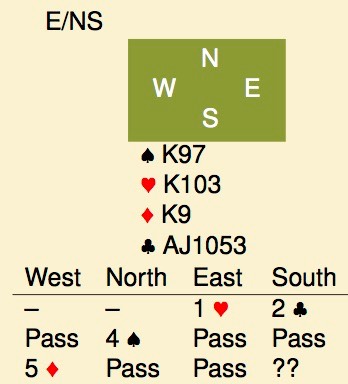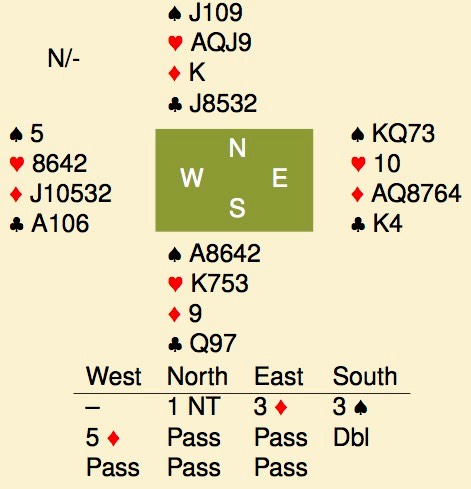Some contracts come up a couple of times every session, with 3NT and 4♠ being the most popular contracts, other contracts are rare, and finally contracts seem to come up in strings, then never again for months. This entry is about the latter. First try them as a problem, as seen from my opponent’s view.
In all cases, matchpoints. The hands are from two episodes of the summer evening drives in the Denktank, the local club.
You pick up this nice collection and hear 1♥ on your left, 2♣ from partner and a pass on your right. You obviously want to bid diamonds, but at this point, you have no forcing diamond bid available, so your options are either some number of diamonds, or 2♥ followed by another number of diamonds, and if so how many? Over 2♣, partner will bid the expected 3♣ to show a minimum overcall. Your choice?

Partner opens a 12-14 NT, balanced but could be slightly off-shape. The next hand overcalls 3♦ natural, when you ask, you hear that there is no way for the opponents to bid just diamonds at the 2 level. Your bid? Note that 3♠ (natural) and 4♦ (both majors) are forcing. Pass obviously isn’t. In either case, the bidding will return to you with 5♦ and a forcing pass from partner. Now what?

1♥ on your right, you overcall 2♥ (not that I’d recommend that on a 5 card suit with flat distribution), pass, 4♠ by partner, pass and you pass. Lefty balances with 5♦, presumably natural but with some heart tolerance, passed back to you. Your turn?
The common factor in these hands, as you might have guessed, is that in all cases, the bididng ended in 5♦x. Let’s see what happened on the hands.

At my table, my RHO opponent decided to bid 2♥, then 5♦ over his partner’s 3♣ rebid. Looking at his hand, that is not completely unreasonable. It didn’t work out when east had an obvious double: 2 certain trump tricks, and with partner not supporting hearts, the _A will almost certainly cash. K. as north not having anything remotely resembling a 2♣ overcall didn’t help either. -500 and 0 matchpoints. The double made a huge difference here, 6 other pairs got to 5♣ or 5♦, undoubled, down 2 for a average score. Top score to the NS pair that passed out 2♥ by EW, down 2 for the only plus score in their direction. Well judged.

The second board. South tried 3♠ in an attempt to introduce his main suit, with the unfortunate effect that over 5♦, the hearts got lost and NS found themselves in a forcing situation. South could only double. After the trump lead, declarer’s problems were over. 5♦ was a shared bottom, for about 10%. 5♥ can be defeated 3 tricks, but EW have to double that and actually get their tricks. If they don’t, you will end up with a positive score.
Board 3: South doubled, ending the auction. While the 5 level is for the opponents, I doubt if this is the right approach. Partner must have 7 spades, for 7 tricks in that suit, a singleton diamond for the auction to make sense, and some club values to warrant a 4♠ bid. That striongly suggests that you can make lots of tricks in a black suit contract, while the opponents have a double fit in the reds. 5♦x went 1 down, but as there are 11 tricks in spades, that is only a 10% score.

At first, it may appear that 5♠ comes down to the club guess, but that is not correct. After (say) the ♦Q lead and continuation, you can draw trumps and play a heart to the ♥K. At that point, you know that west started with 1♠, 2♥ (she’d bid 2♥ with 3 card support earlier on) and 6♦, leaving her with 4♣. East, as a result, then must be 2-6-4-1. Cash the ♣A, if the ♣Q doesn’t drop, run the ♣J. North is a former teammate and I’m pretty sure he’d have found it.
Bottom score went to 4♠ by north, down 1. When asked, K. did not want to discuss how she played the hand. Top score to the pair doubling 5♠. 4♠ or 5♠ making 11 tricks scores a little above average.
If you add this up, I averaged 93% on these 3 5♦x contracts on my way to winning both sessions, making 5♦x the contract of the week for me.
